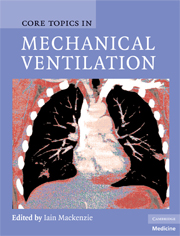Book contents
- Frontmatter
- Contents
- Contributors
- Foreword
- Preface
- Introductory Notes
- 1 Physiology of ventilation and gas exchange
- 2 Assessing the need for ventilatory support
- 3 Oxygen therapy, continuous positive airway pressure and non-invasive ventilation
- 4 Management of the artificial airway
- 5 Modes of mechanical ventilation
- 6 Oxygenation
- 7 Carbon dioxide balance
- 8 Sedation, paralysis and analgesia
- 9 Nutrition in the mechanically ventilated patient
- 10 Mechanical ventilation in asthma and chronic obstructive pulmonary disease
- 11 Mechanical ventilation in patients with blast, burn and chest trauma injuries
- 12 Ventilatory support: extreme solutions
- 13 Heliox in airway obstruction and mechanical ventilation
- 14 Adverse effects and complications of mechanical ventilation
- 15 Mechanical ventilation for transport
- 16 Special considerations in infants and children
- 17 Tracheostomy
- 18 Weaning, extubation and de-cannulation
- 19 Long-term ventilatory support
- 20 The history of mechanical ventilation
- Glossary
- Index
8 - Sedation, paralysis and analgesia
Published online by Cambridge University Press: 14 October 2009
- Frontmatter
- Contents
- Contributors
- Foreword
- Preface
- Introductory Notes
- 1 Physiology of ventilation and gas exchange
- 2 Assessing the need for ventilatory support
- 3 Oxygen therapy, continuous positive airway pressure and non-invasive ventilation
- 4 Management of the artificial airway
- 5 Modes of mechanical ventilation
- 6 Oxygenation
- 7 Carbon dioxide balance
- 8 Sedation, paralysis and analgesia
- 9 Nutrition in the mechanically ventilated patient
- 10 Mechanical ventilation in asthma and chronic obstructive pulmonary disease
- 11 Mechanical ventilation in patients with blast, burn and chest trauma injuries
- 12 Ventilatory support: extreme solutions
- 13 Heliox in airway obstruction and mechanical ventilation
- 14 Adverse effects and complications of mechanical ventilation
- 15 Mechanical ventilation for transport
- 16 Special considerations in infants and children
- 17 Tracheostomy
- 18 Weaning, extubation and de-cannulation
- 19 Long-term ventilatory support
- 20 The history of mechanical ventilation
- Glossary
- Index
Summary
Introduction
The benefits of therapeutic interventions among critically ill, mechanically ventilated, intensive care unit (ICU) patients must outweigh the risk of adverse consequences. The art and science of medicine converge when selecting medications to bring comfort to, and ensure the safety of, mechanically ventilated, critically ill patients. Evidence for improved care of ICU patients has expanded significantly in the last twenty years in this regard. For instance, new data favouring low tidal volume ventilation in acute respiratory distress syndrome (ARDS), recombinant human activated protein C (drotrecogin alfa) for severe sepsis, and conservative fluid management in ARDS have all been proclaimed, if not widely adopted, for their ability to impact both morbidity and mortality. New agents to ensure adequate sedation, paralysis and analgesia of ICU patients are being investigated. The Society of Critical Care Medicine's (SCCM) 2002 guidelines for the use of sedatives and analgesics and for the use of neuromuscular blocking agents (NMBAs) are the most recent consensus recommendations. In weaving art and science together, critical care practitioners constantly seek to improve the quality of life for patients who are frequently unable to relate their anxiety and pain.
Because of the ubiquity of discomfort or pain among mechanically ventilated patients, sustained analgesia is the foundation of therapy.
- Type
- Chapter
- Information
- Core Topics in Mechanical Ventilation , pp. 160 - 183Publisher: Cambridge University PressPrint publication year: 2008

